Services and environments basics
This topic describes Harness Continuous Delivery (CD) services and environments.
If you are new to Harness, please review Harness key concepts and CD pipeline modeling overview.
Video: Services
Video: Services and environments at the account and org level
Services
Services represent your microservices and other workloads. Each service contains a Service Definition that defines your deployment artifacts, manifests or specifications, configuration files, and service-specific variables.
You can create services from:
- An account
- An Organization
- Within a pipeline
- Outside a pipeline
Creating services at an account or organization level
You can create a service at an account or organization level from the Harness UI using APIs or Terraform.
- Pipeline Studio
- API
- Terraform
To create a service at an account or organization level, go to Organization Resources >Services.
Creating an account level service enables you to manage the service globally across the organizations and projects within the account.
An account level service can only reference connectors for the manifests and artifacts within the account. These services are global and cannot have dependencies at a lower hierarchy level.
Shared services can also be created and managed at account or organization levels.
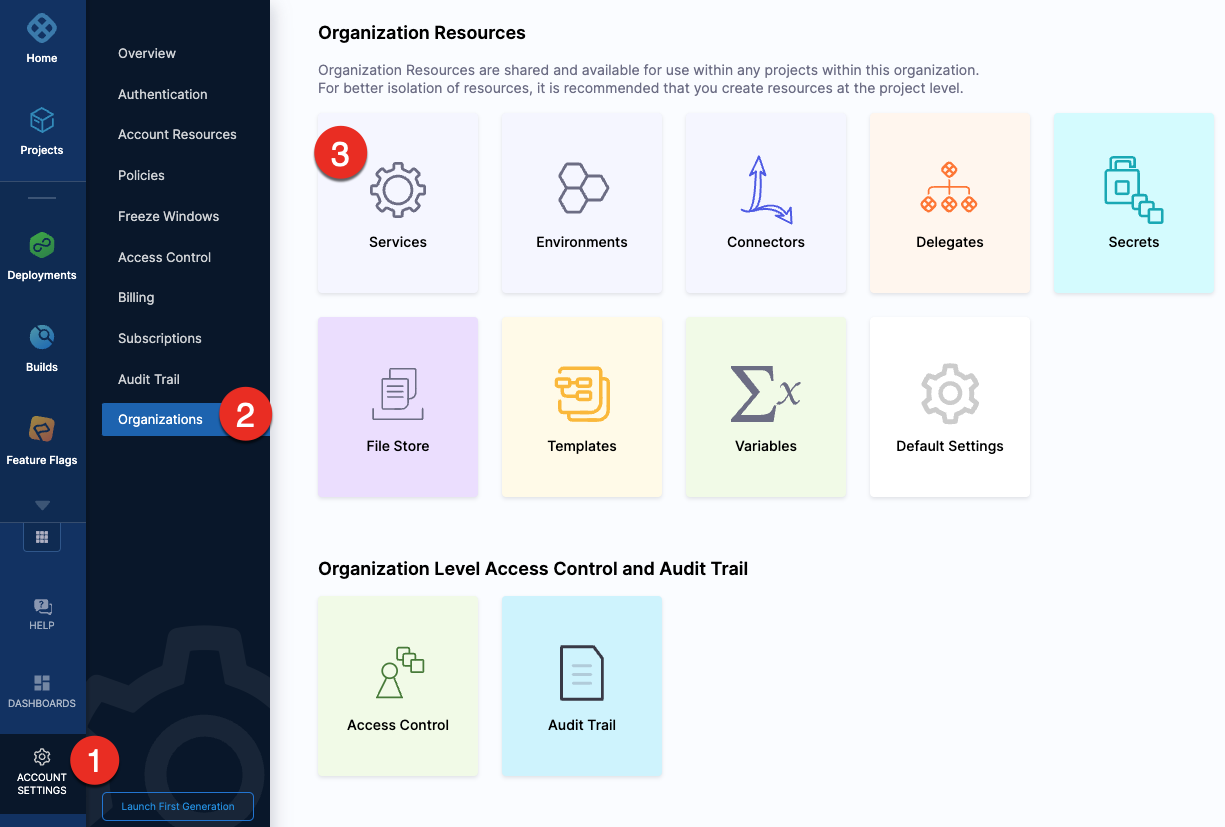
When using an account level deployment stage template, you can referencing an account level service only. Similarly, for organization level stage templates, you can reference organization level services only.
However, when using a deployment stage in a pipeline that has service configured as a runtime input, you can pick services from project, organization, or account levels to pass them as runtime inputs based on your RBAC.
Go to add a stage template for more information.
Expand the section below to see a sample account level service YAML.
Account level service YAML
service:
name: nginx
identifier: nginx
tags: {}
serviceDefinition:
spec:
manifests:
- manifest:
identifier: nginx-base
type: K8sManifest
spec:
store:
type: Github
spec:
connectorRef: account.Harness_K8sManifest
gitFetchType: Branch
paths:
- cdng/
repoName: <+input>
branch: main
skipResourceVersioning: false
artifacts:
primary:
primaryArtifactRef: <+input>
sources:
- spec:
connectorRef: account.Harness_DockerHub
imagePath: library/nginx
tag: <+input>
digest: <+input>
identifier: harness dockerhub
type: DockerRegistry
type: Kubernetes
Expand the section below to see a sample organization level service YAML.
Organization level service YAML
service:
name: redis
identifier: redis
tags: {}
serviceDefinition:
spec:
manifests:
- manifest:
identifier: redis
type: HelmChart
spec:
store:
type: Http
spec:
connectorRef: org.bitnami
chartName: redis
chartVersion: ""
subChartName: ""
helmVersion: V3
skipResourceVersioning: false
enableDeclarativeRollback: false
- manifest:
identifier: Redis Values
type: Values
spec:
store:
type: Github
spec:
connectorRef: account.Rohan_Github
gitFetchType: Branch
paths:
- redis/values.yaml
repoName: Product-Management
branch: main
variables:
- name: namespace
type: String
description: "namespace for the redis service"
value: redis
type: Kubernetes
description: sample redis service
For information about creating a service API, go to create a service.
The orgIdentifier and projectIdentifier field definitions are optional, and depend on where you want to create the service. For example, if you create a service at an account level, you will not need org or project identifiers in the post API call payload.
For information about creating a Harness platform service, go to harness_platform_service (Resource).
The org_id and project_id field definitions are optional, and depend on where you want to create the service. For example, if you create a service at an account level, you will not need org or project identifiers.
Expand the section below to see a sample platform service in Terraform.
Harness platform service
resource "harness_platform_service" "example" {
identifier = "identifier"
name = "name"
description = "test"
org_id = "org_id"
project_id = "project_id"
## SERVICE V2 UPDATE
## We now take in a YAML that can define the service definition for a given Service
## It isn't mandatory for Service creation
## It is mandatory for Service use in a pipeline
yaml = <<-EOT
service:
name: name
identifier: identifier
serviceDefinition:
spec:
manifests:
- manifest:
identifier: manifest1
type: K8sManifest
spec:
store:
type: Github
spec:
connectorRef: <+input>
gitFetchType: Branch
paths:
- files1
repoName: <+input>
branch: master
skipResourceVersioning: false
configFiles:
- configFile:
identifier: configFile1
spec:
store:
type: Harness
spec:
files:
- <+org.description>
variables:
- name: var1
type: String
value: val1
- name: var2
type: String
value: val2
type: Kubernetes
gitOpsEnabled: false
EOT
}
Creating services outside a pipeline
To create a service from outside of a pipeline, you use Services in the navigation pane.
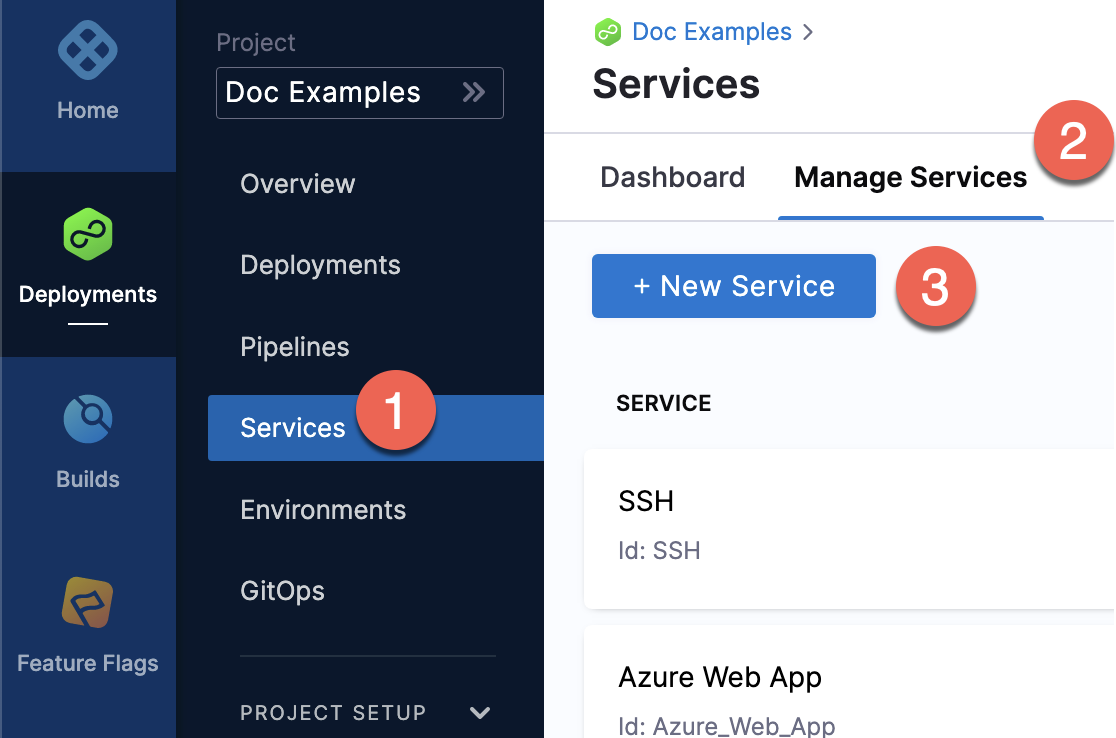
Creating services inside a pipeline
To create a service from inside of a pipeline, select the Services tab of a new CD stage, then select New Service.
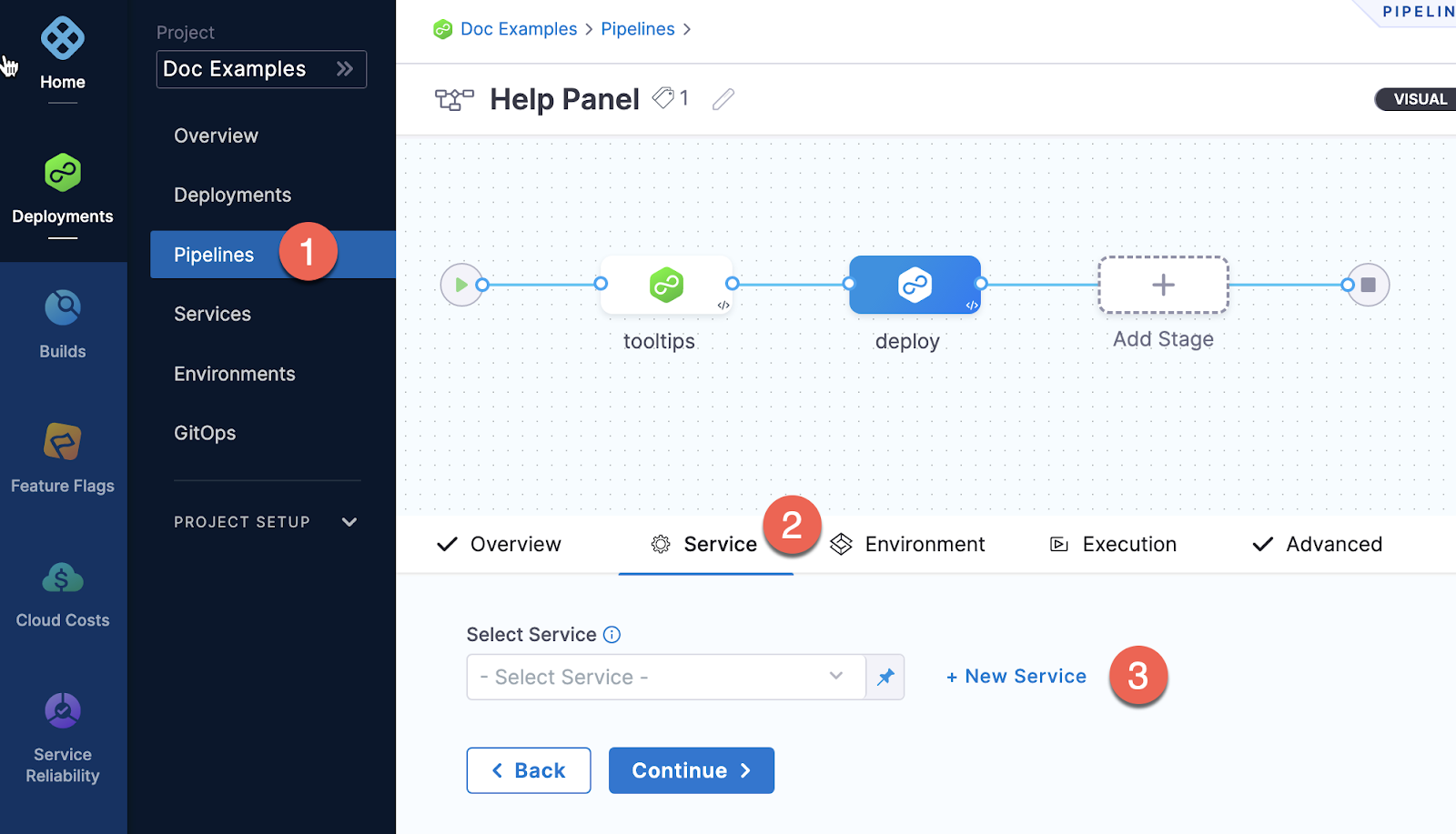
Once the service and its service definition are saved, you can select it in any pipeline.
When you select the service in a pipeline, you can select Edit Service to edit its Service Definition.
When you create the new service you define its Service Definition. For example, a Kubernetes Service Definition with a Kubernetes manifest and Docker artifact.
Environments
Environments represent your deployment targets (QA, Prod, etc). Each environment contains one or more Infrastructure Definitions that list your target clusters, hosts, namespaces, etc.
You can create environments from:
- An Account
- An Organization
- Within a pipeline
- Outside a pipeline
Next you can define all of its settings:
- Configuration: the default environment configuration, including variables, manifests, specifications, and config files that will be used every time the environment is used in a stage.
- Service Overrides: override specific services. You select a service and define what will be overridden whenever that Service is deployed to this environment.
- Infrastructure Definitions: represent one or more environment infrastructures.
- Infrastructure definitions are the actual clusters, hosts, etc., where Harness deploys a service. For example, you might have a QA environment with separate Kubernetes clusters (infrastructure definitions) for each service you want to test.
- You can add multiple infrastructure definitions to a single environment and select an infrastructure definition when you add the environment to a stage.
- GitOps Clusters: adding Harness GitOps clusters to an environment lets you select them as the deployment target in stages. For more information on Harness GitOps, go to Harness GitOps Basics.
Creating environments at an account or organization level
You can create an environment and provide infrastructure definitions at an account or organization level from the Harness UI, using APIs or Terraform.
- Pipeline Studio
- API
- Terraform
To create an environment at an account or organization level, go to Organization Resources >Environments.
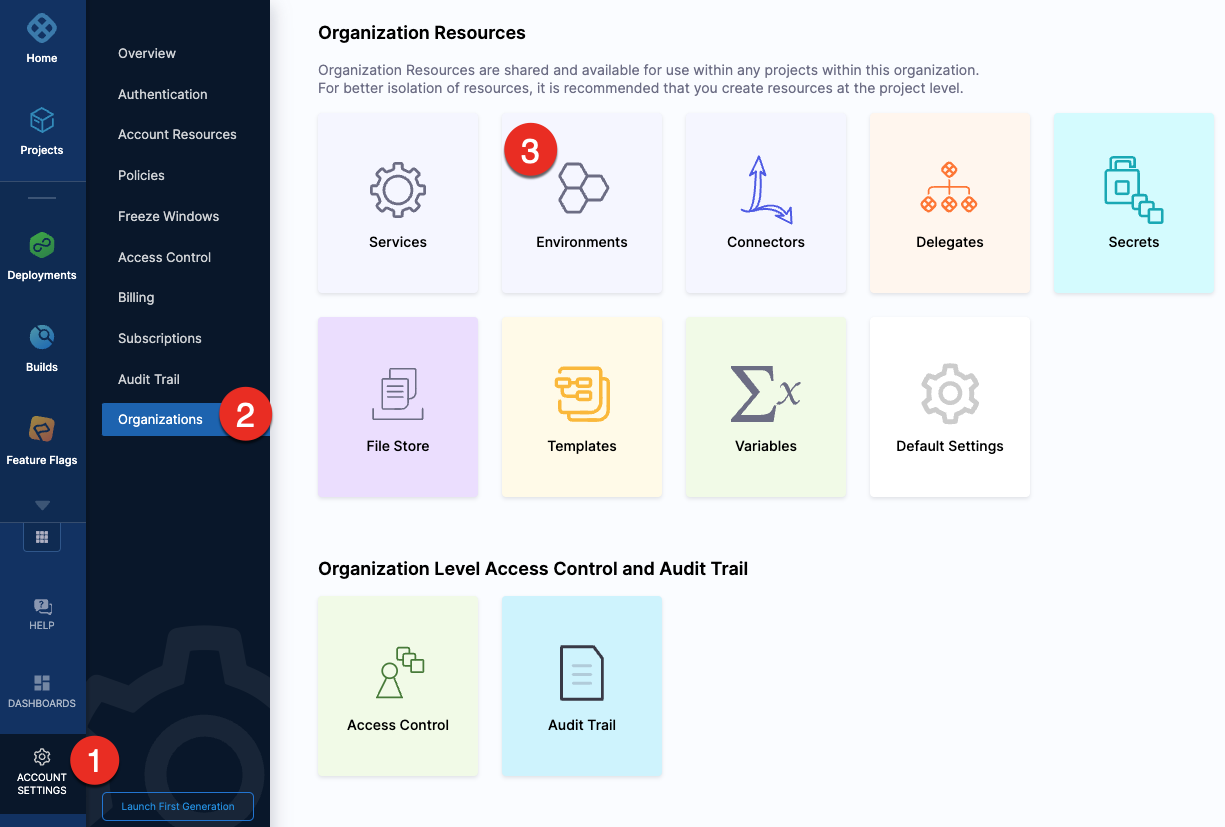
Expand the section below to see a sample account level environment YAML.
Account level environment YAML
environment:
name: dev
identifier: dev
description: account wide dev environment
tags:
status: non-regulated
type: PreProduction
variables:
- name: port
type: String
value: "8080"
description: ""
- name: namespace
type: String
value: <+service.name>-dev
description: "namespace environment variable"
Expand the section below to see a sample account level infrastructure definition YAML.
Account level infrastructure definition YAML
infrastructureDefinition:
name: dev-k8s
identifier: dev
description: development Kubernetes cluster
tags: {}
environmentRef: dev
deploymentType: Kubernetes
type: KubernetesDirect
spec:
connectorRef: account.Harness_Kubernetes_Cluster
namespace: <+service.name>-dev
releaseName: release-<+INFRA_KEY>
allowSimultaneousDeployments: false
Expand the section below to see a sample organization level environment YAML.
Organization level environment YAML
environment:
name: prod
identifier: prod
description: production environment for the organization
tags:
status: regulated
type: Production
orgIdentifier: default
variables:
- name: namespace
type: String
value: <+service.name>-prod
description: "namespace for prod environment"
- name: port
type: String
value: "8080"
description: "port for prod environment"
Expand the section below to see a sample organization level infrastructure definition YAML.
Organization level infrastructure definition YAML
infrastructureDefinition:
name: prod-k8s
identifier: prodk8s
description: production kubernetes cluster
tags: {}
orgIdentifier: default
environmentRef: prod
deploymentType: Kubernetes
type: KubernetesDirect
spec:
connectorRef: account.Harness_Kubernetes_Cluster
namespace: production
releaseName: release-<+INFRA_KEY>
allowSimultaneousDeployments: false
For information about creating an environment API, go to create an environment.
For information about creating infrastructure definition API, go to create an infrastructure in an environment.
The orgIdentifier and projectIdentifier field definitions are optional, and depend on where you want to create the environment. For example, if you create an environment at an account level, you will not need org or project identifiers in the post API call payload.
For information about creating a Harness platform environment, go to harness_platform_environment (Resource).
Expand the section below to see a sample platform environment in Terraform.
Harness platform environment
resource "harness_platform_environment" "example" {
identifier = "identifier"
name = "name"
org_id = "org_id"
project_id = "project_id"
tags = ["foo:bar", "baz"]
type = "PreProduction"
## ENVIRONMENT V2 Update
## The YAML is needed if you want to define the Environment Variables and Overrides for the environment
## Not Mandatory for Environment Creation nor Pipeline Usage
yaml = <<-EOT
environment:
name: name
identifier: identifier
orgIdentifier: org_id
projectIdentifier: project_id
type: PreProduction
tags:
foo: bar
baz: ""
variables:
- name: envVar1
type: String
value: v1
description: ""
- name: envVar2
type: String
value: v2
description: ""
overrides:
manifests:
- manifest:
identifier: manifestEnv
type: Values
spec:
store:
type: Git
spec:
connectorRef: <+input>
gitFetchType: Branch
paths:
- file1
repoName: <+input>
branch: master
configFiles:
- configFile:
identifier: configFileEnv
spec:
store:
type: Harness
spec:
files:
- account:/Add-ons/svcOverrideTest
secretFiles: []
EOT
}
For information about creating a Harness platform infrastructure definition, go to harness_platform_infrastructure (Resource).
Expand the section below to see a sample platform infrastructure definition in Terraform.
Harness platform infrastructure definition
resource "harness_platform_infrastructure" "example" {
identifier = "identifier"
name = "name"
org_id = "orgIdentifer"
project_id = "projectIdentifier"
env_id = "environmentIdentifier"
type = "KubernetesDirect"
deployment_type = "Kubernetes"
yaml = <<-EOT
infrastructureDefinition:
name: name
identifier: identifier
description: ""
tags:
asda: ""
orgIdentifier: orgIdentifer
projectIdentifier: projectIdentifier
environmentRef: environmentIdentifier
deploymentType: Kubernetes
type: KubernetesDirect
spec:
connectorRef: account.gfgf
namespace: asdasdsa
releaseName: release-<+INFRA_KEY>
allowSimultaneousDeployments: false
EOT
}
The org_id and project_id field definitions are optional, and depend on where you want to create the environment. For example, if you create an environment at an account level, you will not need org or project identifiers.
Creating environments inside a pipeline
To create an environment from inside of a pipeline, select New Environment in the Infrastructure tab of a new CD stage.
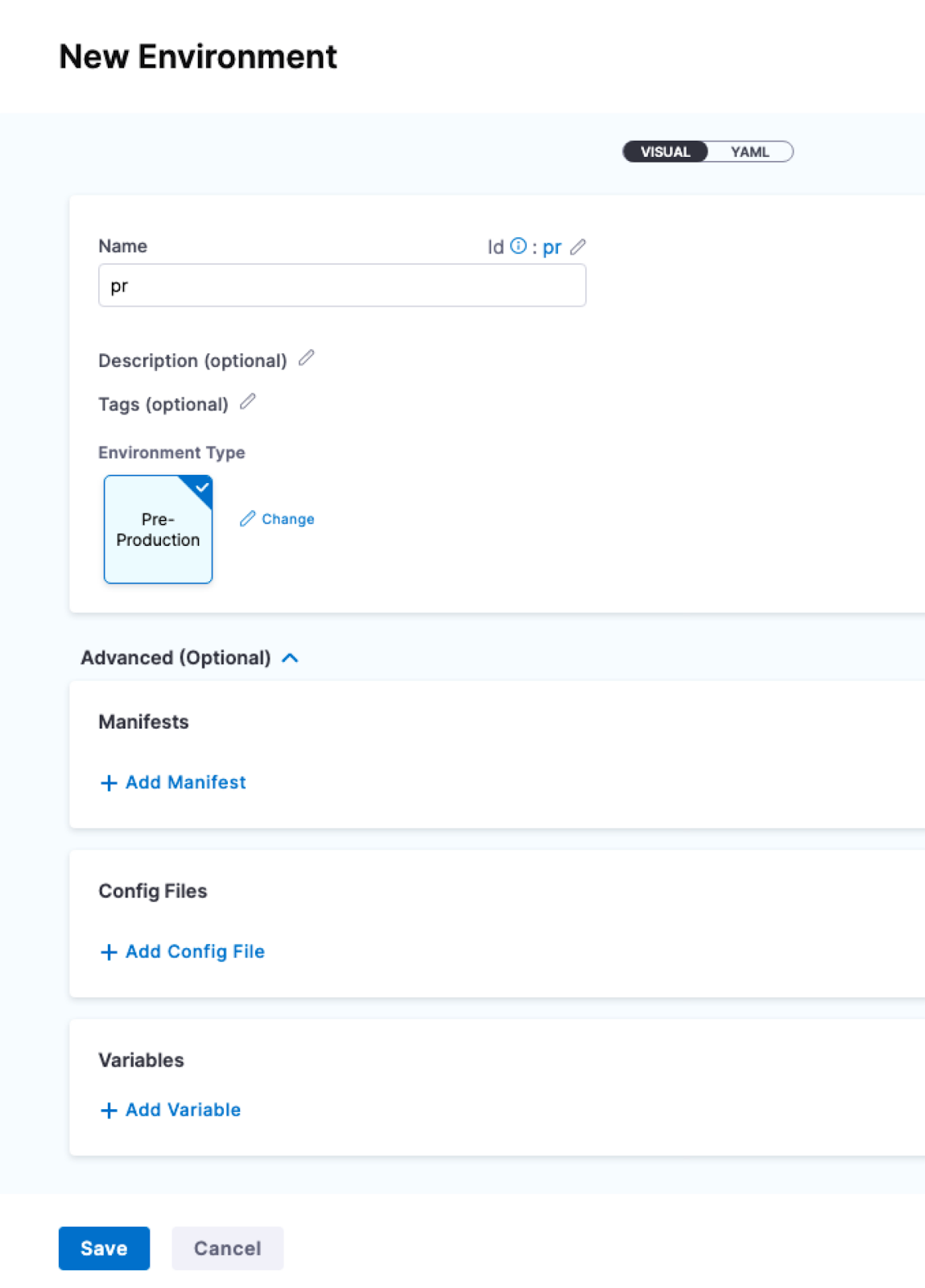
Creating environments outside a pipeline
To create an Environment from outside of a pipeline, you use Environments in the navigation pane.
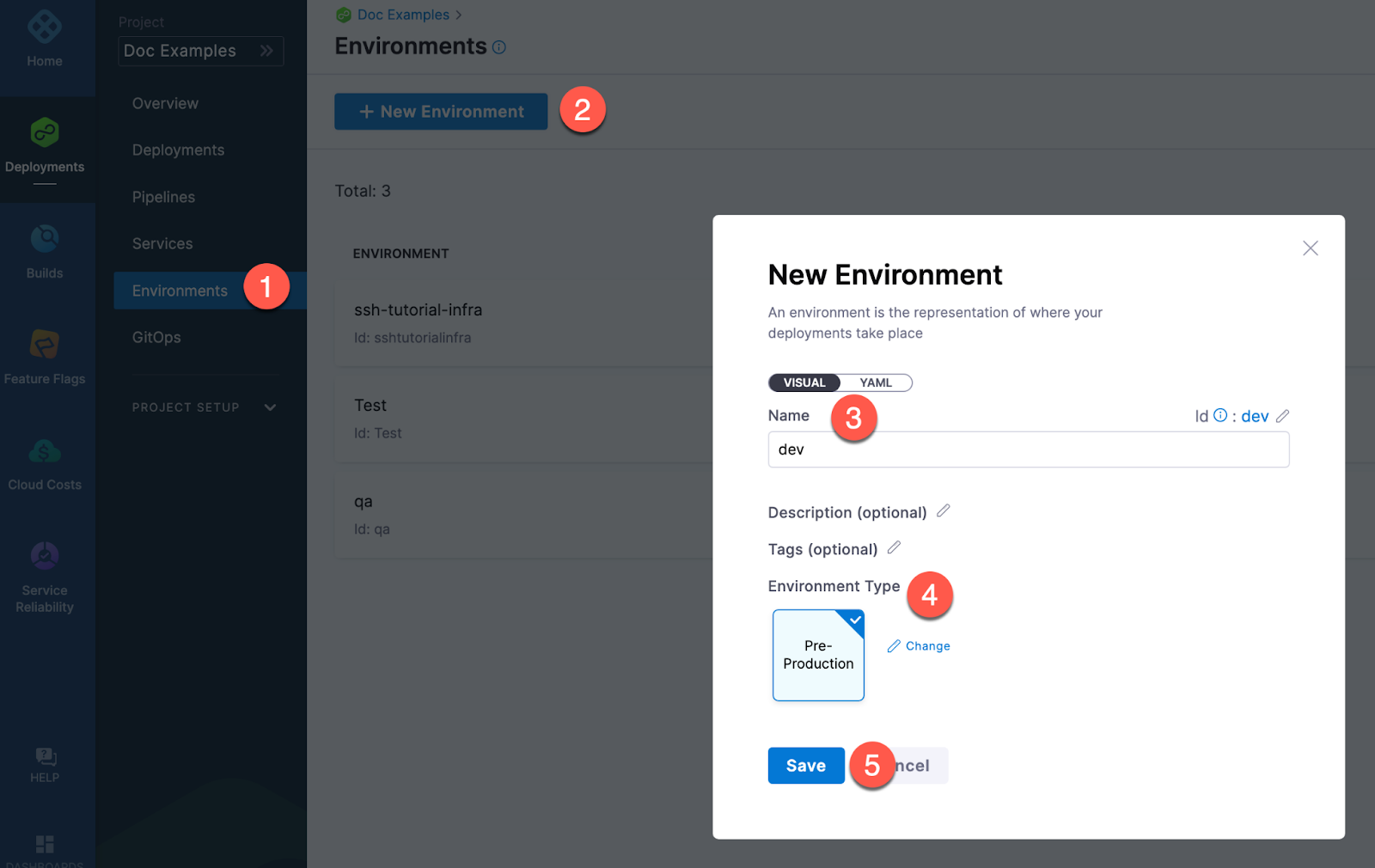
Configuration
In the environment Configuration, you can manage the Name, Description, Tags, and Environment Type of the environment.
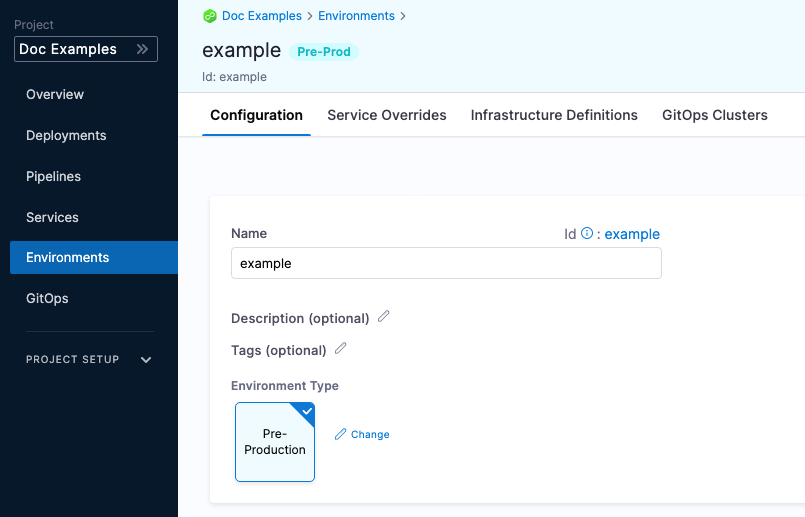
You can also set default manifests, specifications, config files, and variables to use whenever Harness deploys a service to this environment.
For example, a stage has a Kubernetes service with a manifest but whenever that service is deployed to the QA environment, the manifest in that environment's Configuration overwrites the namespace of with the manifest in the service with QA.
Service overrides
Service overrides are different from Environment Configuration in the following ways:
- Environment Configuration: applies to every service that is used with the environment.
- Environment Service Overrides: applies to specific services you select. Whenever that service is used with that environment, the Service Override is applied.
Runtime inputs are not supported if you are trying to override services in multi-service and multi-environment set ups.
Override priority
When you are using environment configuration and service override to override service settings, it's important to understand the priority of the overrides.
The priority from top to bottom is:
- Environment service overrides
- Environment configuration
- Service settings
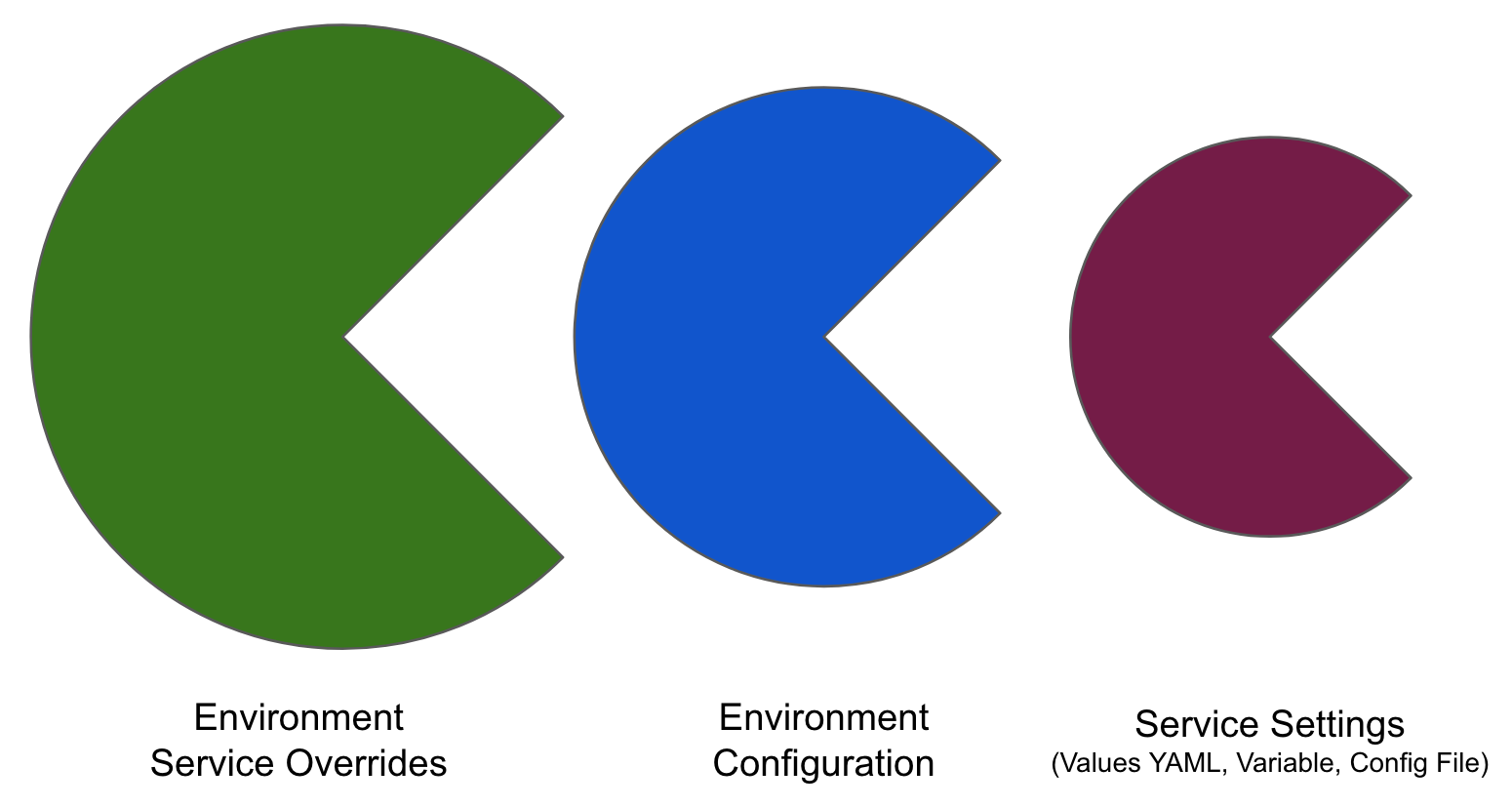
Override priority example
Suppose you have a pipeline that runs as follows:
- Deploys a service named
myService, which has a variablecpuset to 1. - Deploys
myServicetomyEnvironmentAlpha, and then overrides themyServicevariablecpuvalue to 2.
In this case, the environment variable takes precedence, and overrides the service variable. When the pipeline runs, it uses the cpu value of 2.
Now, suppose you have a another pipeline that deploys myService to myEnvironmentKappa, which has a service override that sets cpu to 4. In this case, the environment service override takes precedence over the environment configuration and the service setting. When the pipeline runs, it uses the cpu value of 4.
Infrastructure definitions
Infrastructure definitions represent an environment's infrastructures physically. They are the actual clusters, hosts, namespaces, etc, where you are deploying a service.
An environment can have multiple Infrastructure Definitions.
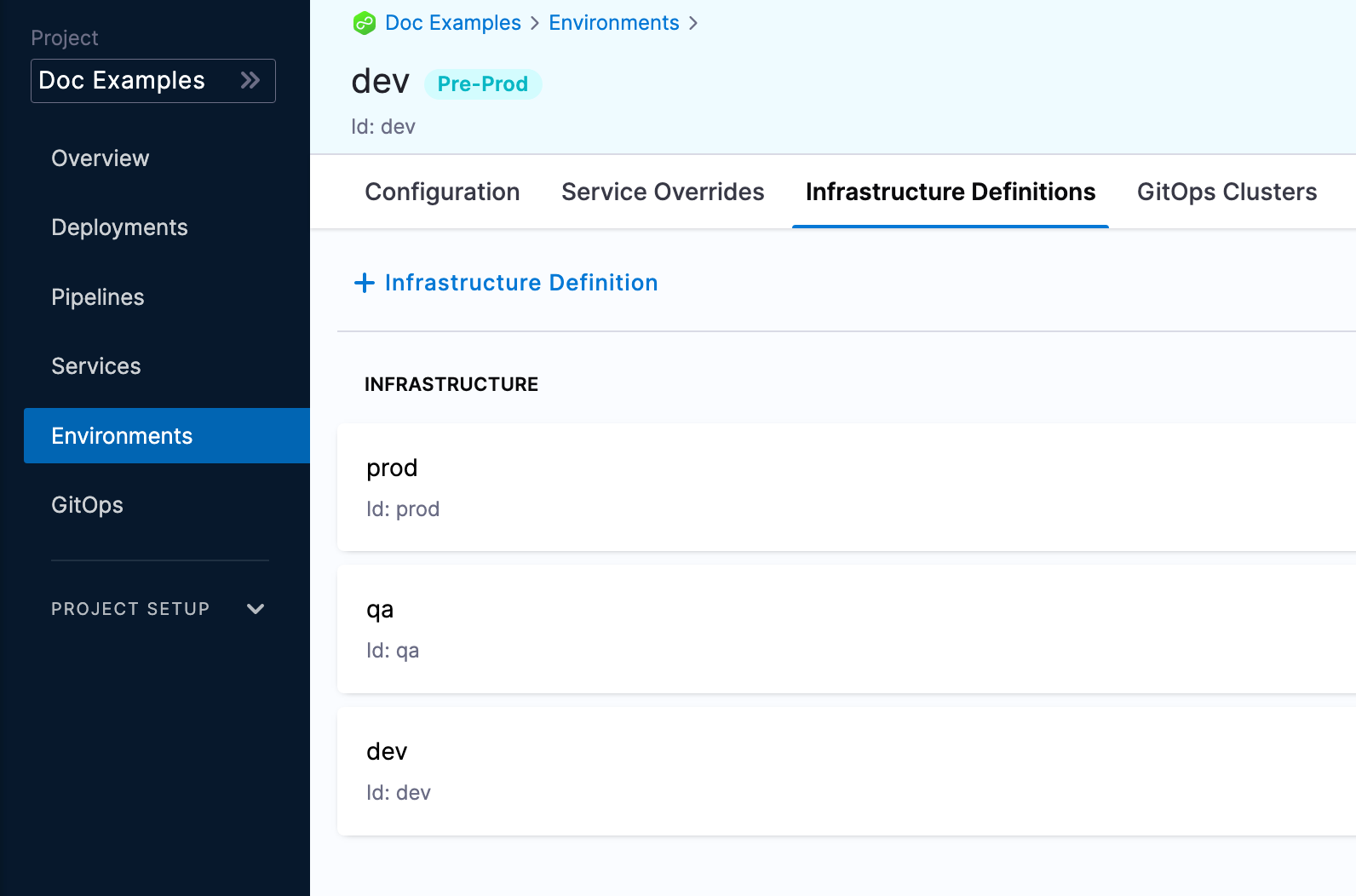
When you select an environment in a stage, you can select the Infrastructure Definition to use for that stage.

Infrastructure Tags
Tags can be attached to infrastructure definitions representing their characteristics. These tags can be key value pairs.

When you select the Infrastructure Definition for a stage, the attached tags can be accessed using their keys with the expression, <+infra.tags.tag_key>. This expression is available for use throughout the stage.
For example, skipping certain steps in pipeline based on the tags attached to the infrastructure.
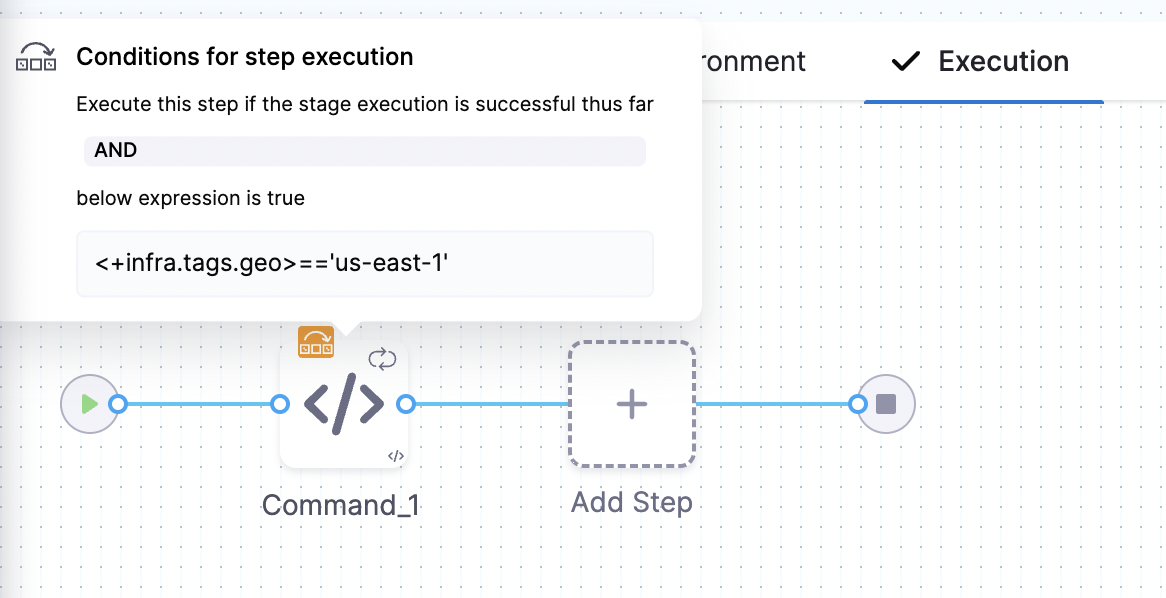
Values YAML overrides and merges
You can specify values YAML files at the environment's Service Overrides and Configuration, and the service itself.
Here is an example of specifying it at the environment's Configuration:
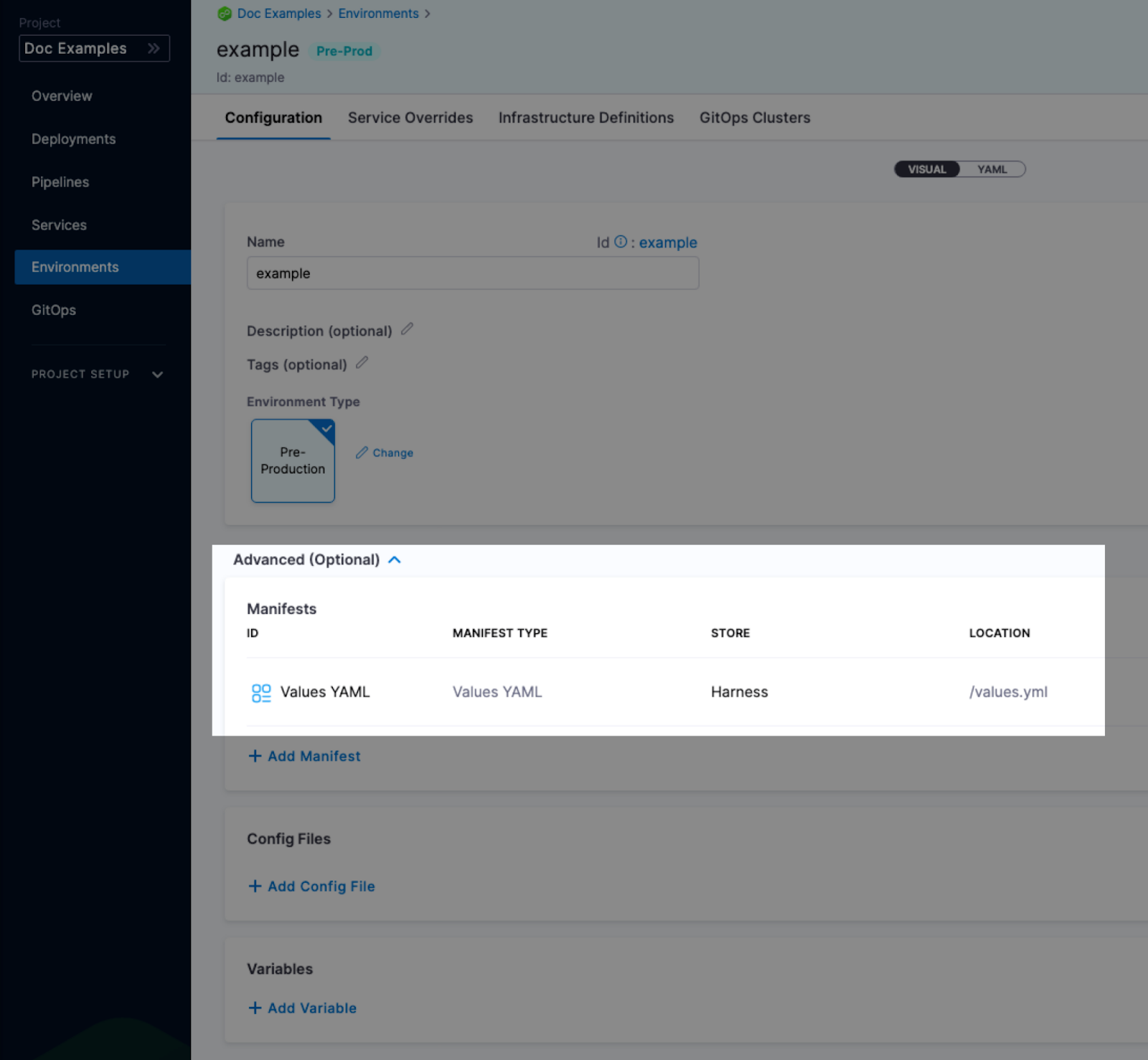
When you have a values yaml file at two or more of the environment Service Overrides, Environment Configuration, and the service itself, Harness merges the files into a single values YAML for deployment. This merging is performed at pipeline execution runtime.
Overriding occurs when the higher priority setting has the same name:value pair as a lower priority setting.
Let's look at two examples.
Merging values YAML name:value pairs
An environment's Service Overrides values YAML has the name:value pair servicePort: 80 but no replicas name:value.
A service's Service Definition has a values YAML with replicas: 2 but no servicePort name:value.
At runtime, the two values YAML files are merged into one.
The servicePort: 80 from the environment Service Overrides values YAML is merged with the Service Definition's replicas: 2 in the values YAML:
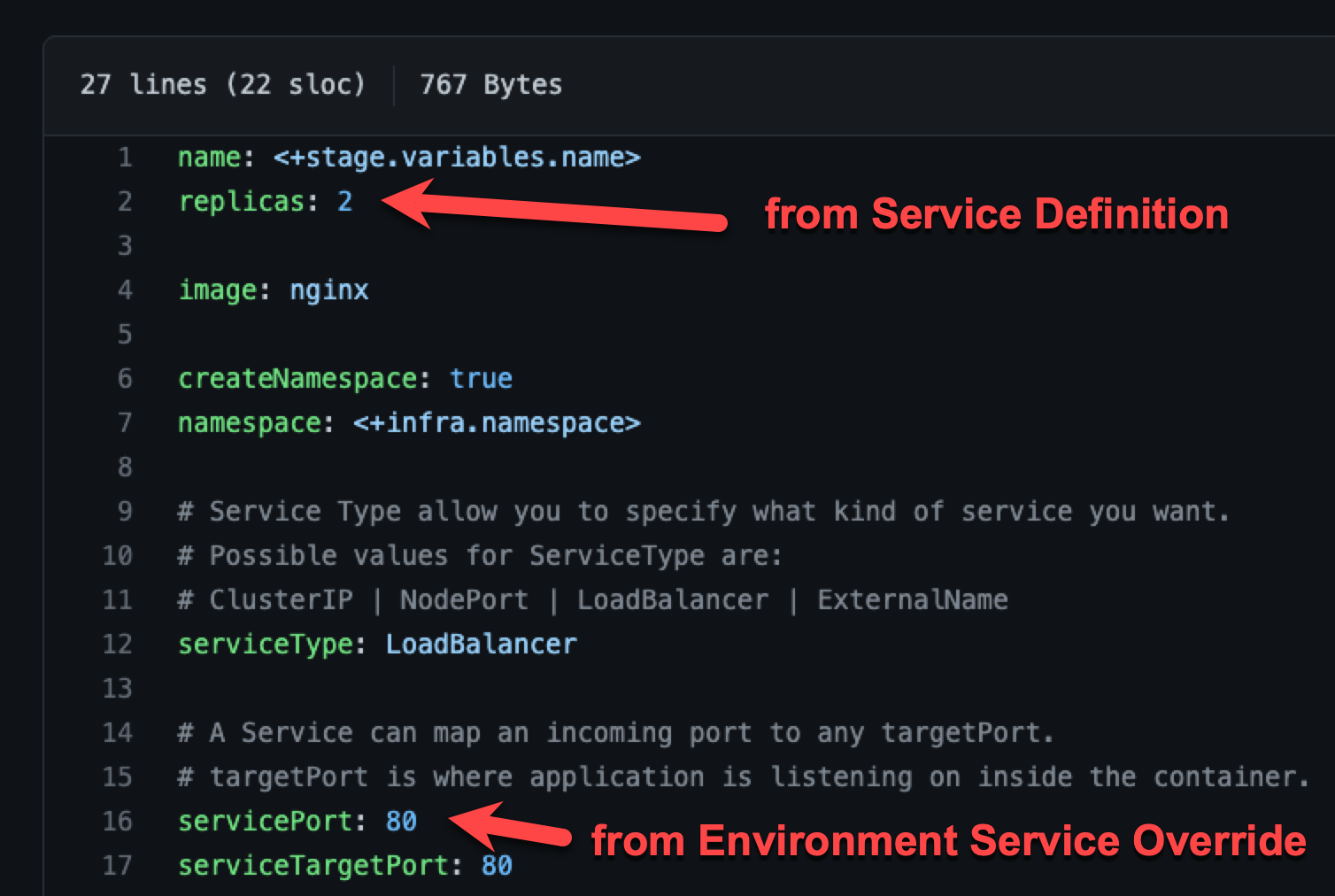
Fully overriding values YAML name:value pairs
An environment's Service Overrides values YAML has the name:value pairs replicas: 2 and servicePort: 80.
A service's Service Definition has a values YAML with replicas: 4 and servicePort: 8080.
At runtime, the name:value pairs from the environment Service Overrides values YAML fully override the service values YAML. The replicas: 2 and servicePort: 80 from the environment Service Overrides are used.
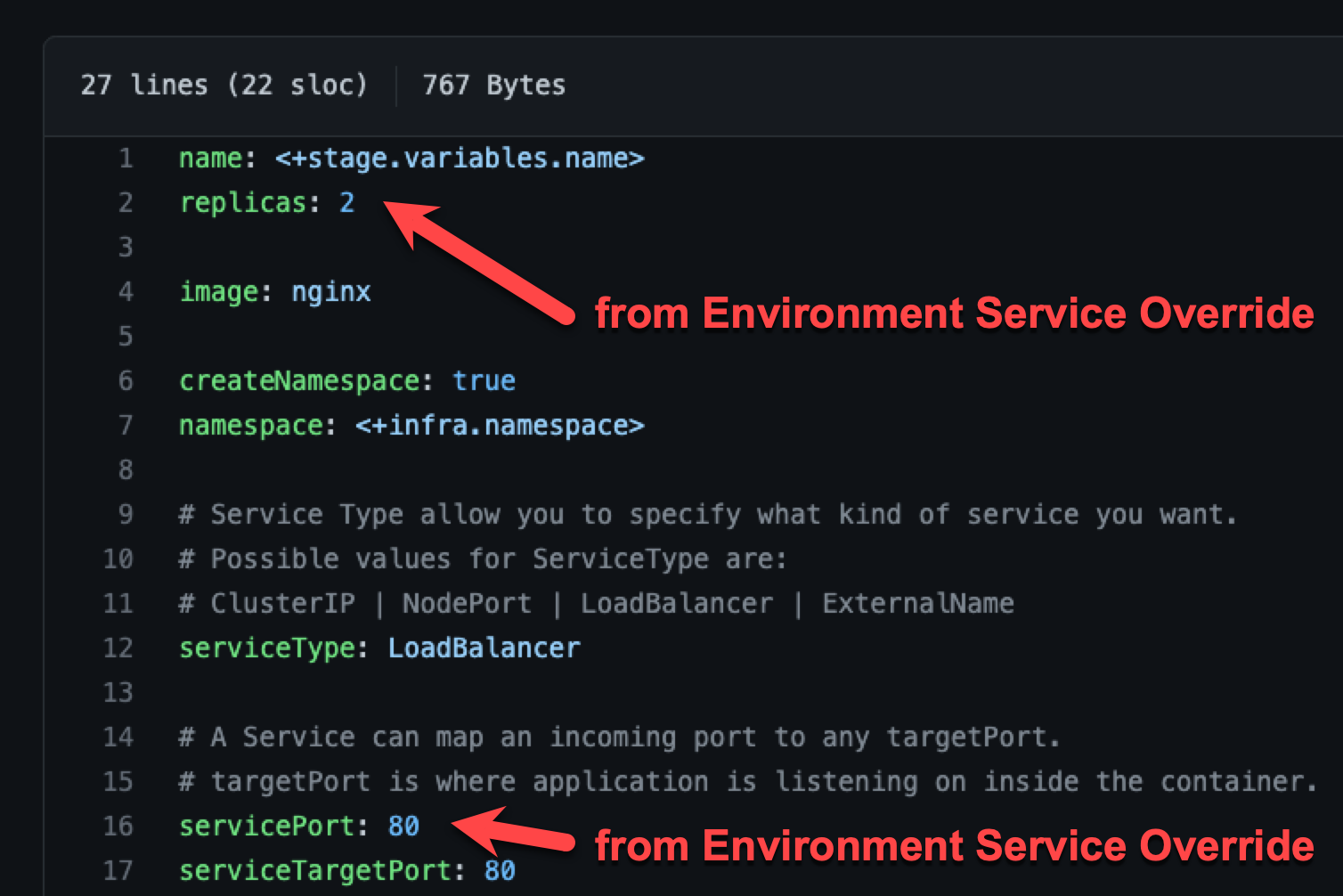
Config files and variables are completely overridden
Config files are a black box that can contain multiple formats and content, such as YAML, JSON, plain text, etc. Consequently, they cannot be overridden like Values YAML files.
Variables cannot be partially overridden either. They are completely replaced.
When you have Config files at two or more of the environment Service Overrides, Configuration, and the service itself, the standard override priority is applied.
When you have Variables with the same name at two or more of the environment Service Overrides, Configuration, and the service itself, the standard override priority is applied.
GitOps Clusters
When you use Harness GitOps you can add GitOps clusters to an environment.
To learn more about Harness GitOps, go to Harness GitOps Basics.
Next, when you create a pipeline, you can select the environment and the GitOps cluster(s) to use.

GitOps clusters are used in a PR pipeline. A PR pipeline creates and merges a Git PR on the config.json for a destination cluster as part of an ApplicationSet. The PR Pipeline runs, merges a change to the config.json, and a GitOps sync on the ApplicationSet is initiated.
GitOps Clusters are not used in standard CD pipelines. They're used when using GitOps only.
Runtime inputs and expressions in services and environments
If you use runtime inputs in your services and environments, users will need to provide values for these when they run pipeline using these services and environments.
If you use expressions in your services and environments, Harness must be able to resolve these expressions when users run pipeline using these services and environments.
Select Runtime input for the service and environment.
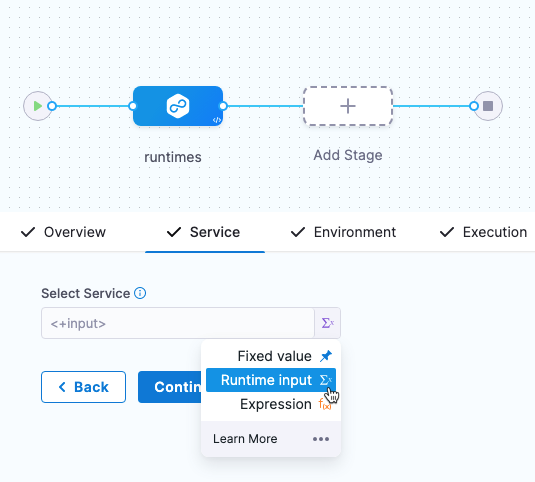
When you run the pipeline, you can select the service and environment for their runtime inputs.
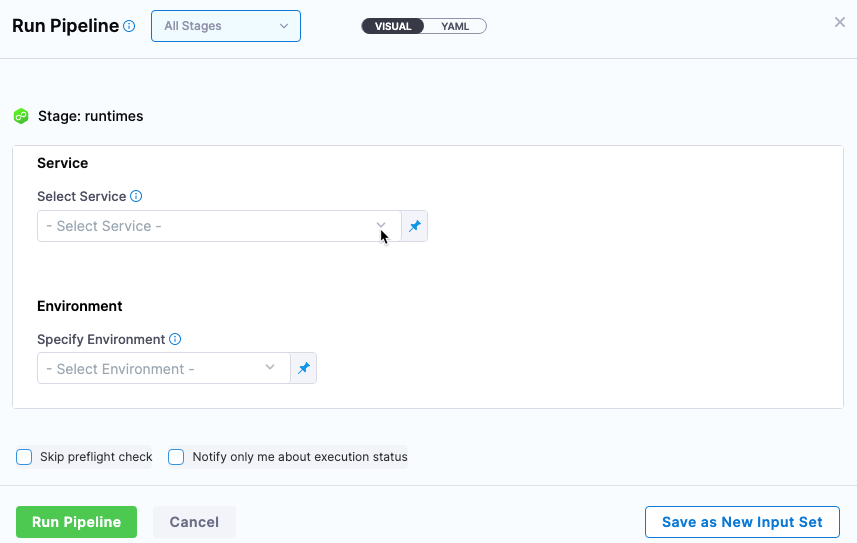
For more information on runtime inputs and expressions, go to Fixed Values, Runtime Inputs, and Expressions.
Services and environments RBAC
Please review these key RBAC uses cases for services and environments.
For extensive information on Harness RBAC, go to Harness Role-Based Access Control Overview and Harness Role-Based Access Control Quickstart.
Access permission is needed to deploy to a service or environment
One of the most important advantages of services and environments is the ability to define roles that determines who can deploy them.
In order for a role to allow deployments using services and/or environments, the role must have the access permission enabled for services and/or environments.
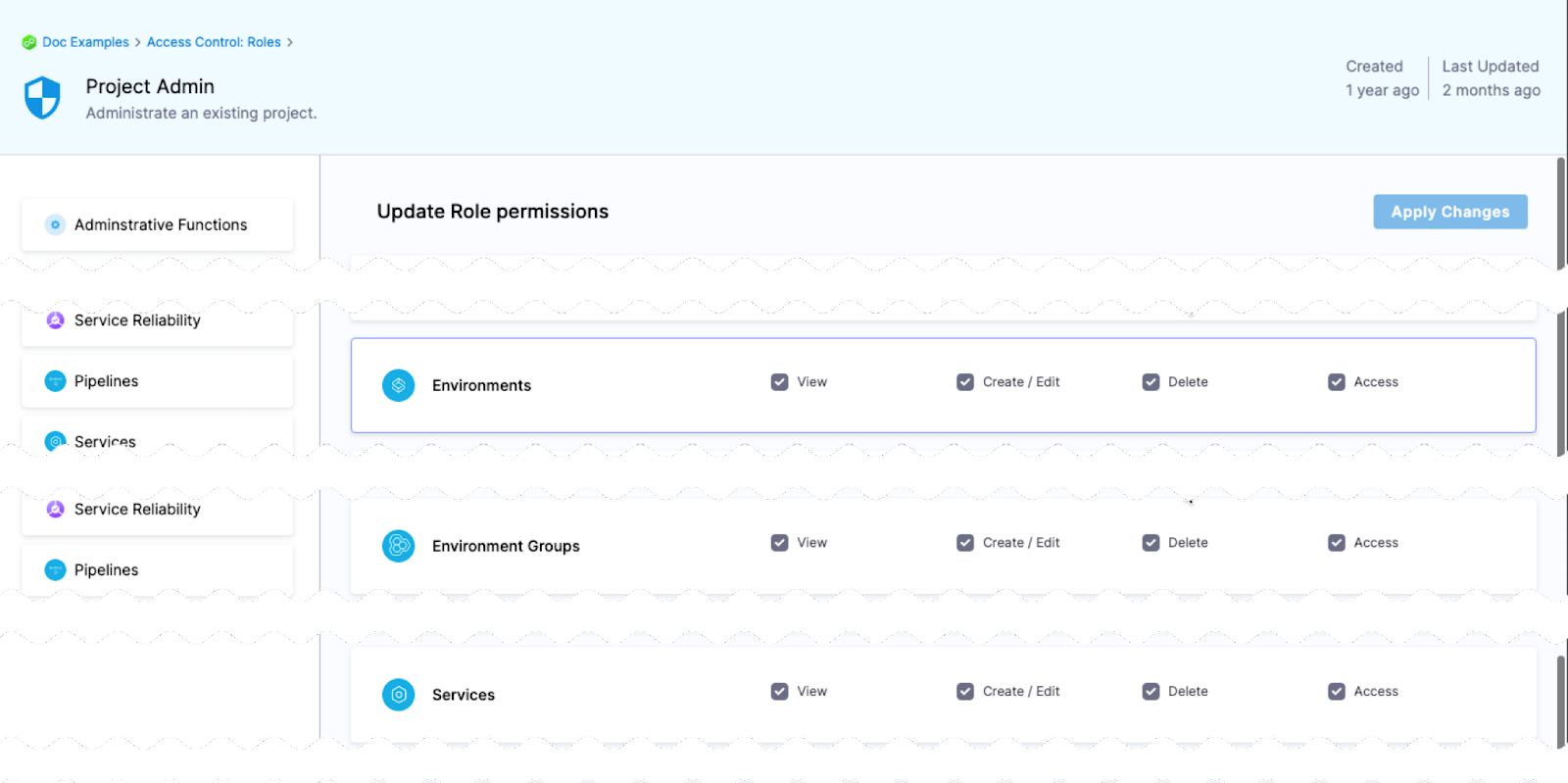
The View, Create, Edit, Delete, and Manage permissions enable you to deploy a service and environment.
If a role does not have the Access permission for Environments, a user or user group assigned that role cannot deploy to any environment.
If a role does not have the Access permission for Services, a user or user group assigned that role cannot deploy any service.
Restrict access to specific services or environments for a user or user group
You can restrict a user or user group to using specific services and environments only. The process is the same for services and environments.
Let's look at an example using environments.
If you want to restrict a user or user group to deploy to a specific environment only, do the following:
- Create a resource group and select the environment.
- Create a Role and give the user or user group permissions. The Access permission is needed for deployments.
- Assign the role and resource group to the user or user group.
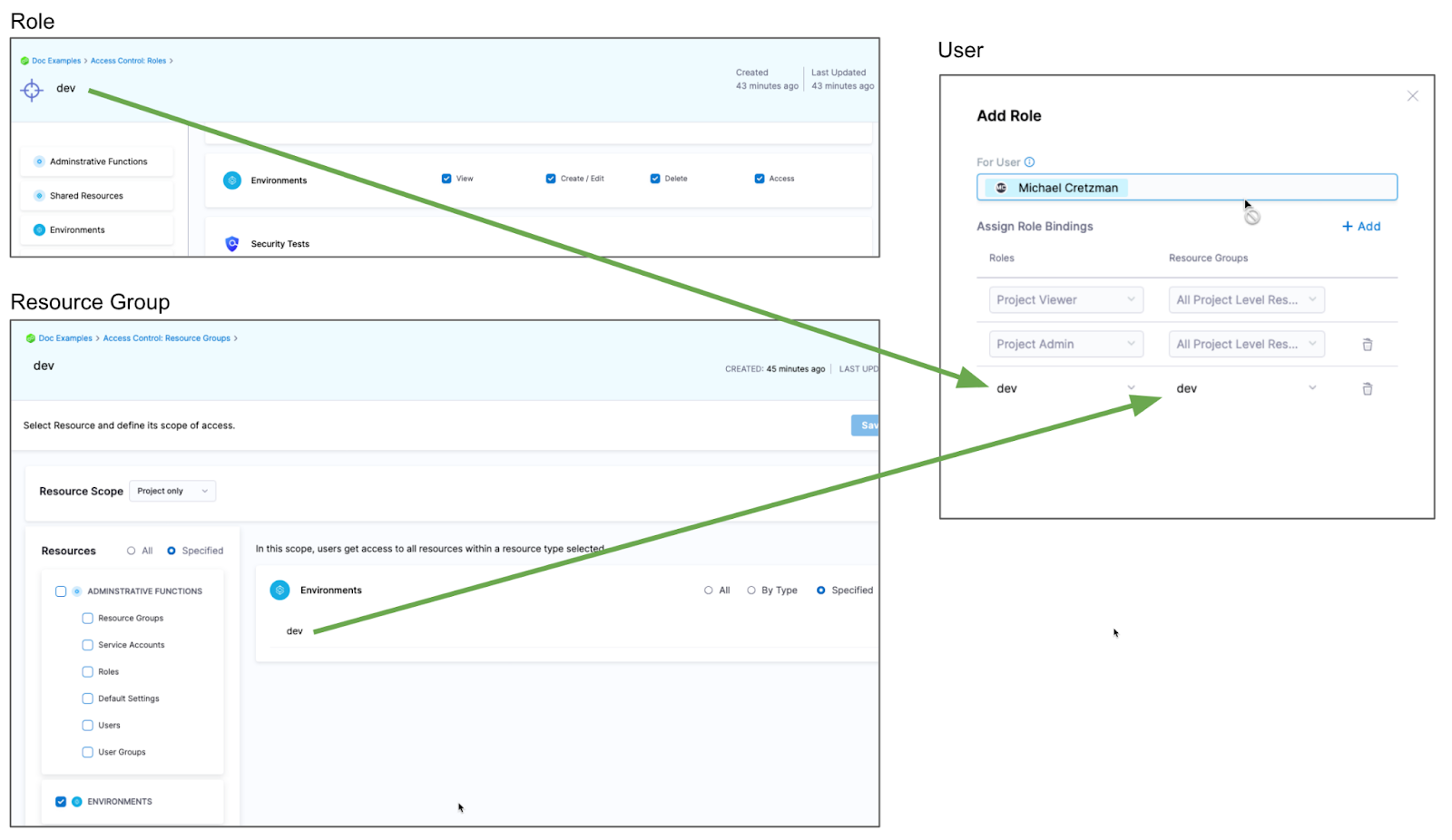
Environment groups
Environment groups are simple a way to group environments so you can assign permissions to multiple environments in a role.
